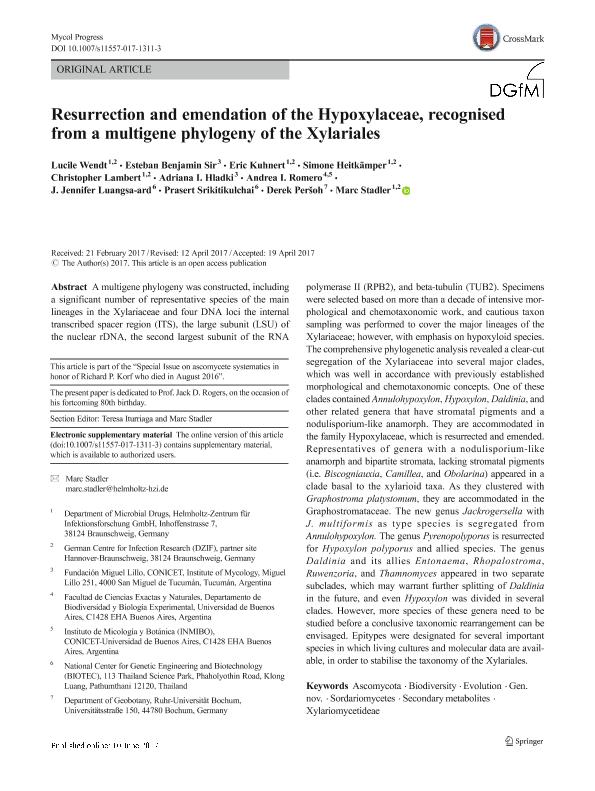Artículo
Resurrection and emendation of the Hypoxylaceae, recognised from a multigene phylogeny of the Xylariales
Wendt, Lucile; Sir, Esteban Benjamin ; Kuhnert, Eric; Heitkämper, Simone; Lambert, Christopher; Hladki, Adriana I.; Romero, Andrea Irene
; Kuhnert, Eric; Heitkämper, Simone; Lambert, Christopher; Hladki, Adriana I.; Romero, Andrea Irene ; Luangsa-Ard, Janet Jennifer; Srikitikulchai, Prasert; Peršoh, Derek; Stadler, Marc
; Luangsa-Ard, Janet Jennifer; Srikitikulchai, Prasert; Peršoh, Derek; Stadler, Marc
 ; Kuhnert, Eric; Heitkämper, Simone; Lambert, Christopher; Hladki, Adriana I.; Romero, Andrea Irene
; Kuhnert, Eric; Heitkämper, Simone; Lambert, Christopher; Hladki, Adriana I.; Romero, Andrea Irene ; Luangsa-Ard, Janet Jennifer; Srikitikulchai, Prasert; Peršoh, Derek; Stadler, Marc
; Luangsa-Ard, Janet Jennifer; Srikitikulchai, Prasert; Peršoh, Derek; Stadler, Marc
Fecha de publicación:
10/06/2017
Editorial:
Springer Heidelberg
Revista:
Mycological Progress
ISSN:
1617-416X
e-ISSN:
1861-8952
Idioma:
Inglés
Tipo de recurso:
Artículo publicado
Clasificación temática:
Resumen
A multigene phylogeny was constructed, including a significant number of representative species of the main lineages in the Xylariaceae and four DNA loci the internal transcribed spacer region (ITS), the large subunit (LSU) of the nuclear rDNA, the second largest subunit of the RNA polymerase II (RPB2), and beta-tubulin (TUB2). Specimens were selected based on more than a decade of intensive morphological and chemotaxonomic work, and cautious taxon sampling was performed to cover the major lineages of the Xylariaceae; however, with emphasis on hypoxyloid species. The comprehensive phylogenetic analysis revealed a clear-cut segregation of the Xylariaceae into several major clades, which was well in accordance with previously established morphological and chemotaxonomic concepts. One of these clades contained Annulohypoxylon, Hypoxylon, Daldinia, and other related genera that have stromatal pigments and a nodulisporium-like anamorph. They are accommodated in the family Hypoxylaceae, which is resurrected and emended. Representatives of genera with a nodulisporium-like anamorph and bipartite stromata, lacking stromatal pigments (i.e. Biscogniauxia, Camillea, and Obolarina) appeared in a clade basal to the xylarioid taxa. As they clustered with Graphostroma platystomum, they are accommodated in the Graphostromataceae. The new genus Jackrogersella with J. multiformis as type species is segregated from Annulohypoxylon. The genus Pyrenopolyporus is resurrected for Hypoxylon polyporus and allied species. The genus Daldinia and its allies Entonaema, Rhopalostroma, Ruwenzoria, and Thamnomyces appeared in two separate subclades, which may warrant further splitting of Daldinia in the future, and even Hypoxylon was divided in several clades. However, more species of these genera need to be studied before a conclusive taxonomic rearrangement can be envisaged. Epitypes were designated for several important species in which living cultures and molecular data are available, in order to stabilise the taxonomy of the Xylariales.
Archivos asociados
Licencia
Identificadores
Colecciones
Articulos(INMIBO (EX - PROPLAME))
Articulos de INSTITUTO DE MICOLOGIA Y BOTANICA
Articulos de INSTITUTO DE MICOLOGIA Y BOTANICA
Citación
Wendt, Lucile; Sir, Esteban Benjamin; Kuhnert, Eric; Heitkämper, Simone; Lambert, Christopher; et al.; Resurrection and emendation of the Hypoxylaceae, recognised from a multigene phylogeny of the Xylariales; Springer Heidelberg; Mycological Progress; 10-6-2017; 1-40
Compartir
Altmétricas



